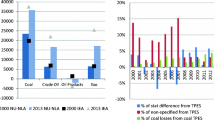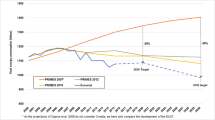Abstract
The aim of this paper is to analyse the changes in final energy consumption in Andalusia through logarithmic mean Divisia index (LMDI) decomposition analysis during the period 2003–2012. The results lead us to conclude that a reduction of final energy (FE) consumption of 1 % took place as a result of a diminishing in structural effect by 11 % and an increase in the activity effect and intensity effect by 7.4 and 3.5 %, respectively. Chain-linked LMDI decomposition shows the existence of two sub-periods, with a turning point in 2008. The first period, coinciding to a great extent with the Andalusian Energy Plan 2003–2006 (PLEAN), showed an increase in final energy consumption, mostly due to the activity effect but also to the intensity effect. The second period, coinciding with the implementation of the Andalusian Sustainable Energy Plan 2007–2013 (PASENER), shows a reduction in the activity, structure and intensity effects. The results allow us to conclude that many of the energy efficiency measures, implemented through the PASENER, are related to sectors that experienced a decline in energy consumption due to the intensity effect, such as transport, primary and service sectors. Additionally, although they were included in PASENER, more policy attention should be given to the energy transformation, residential and industrial sectors which increased the demand for energy due to the intensity effect during this period. Finally, the energy-saving behaviour of economic agents due to the economic downturn should also be considered as an explanation for the diminishing in energy consumption during this sub-period.



Similar content being viewed by others
Notes
Following the definition by the International Energy Agency (IEA 2004), the non-energy uses are excluded. Non-energy use includes energy products used as raw materials in the different sectors, which are not consumed as fuel or transformed into another fuel. For example, most lubricants and bitumen are used for non-energy purposes; similarly, natural gas is used as a raw material for the petrochemical industry, etc.
References
AEA (2012). Agencia Andaluza de la Energía http://www.agenciaandaluzadelaenergia.es/info-web/loginController (accessed 15.11.2012).
AEA (2013). Agencia Andaluza de la Energía http://www.agenciaandaluzadelaenergia.es/ciudadania/estadistica-info-energia (accessed 28.04.2013).
AEA (2014). Borrador Estrategia Energética de Andalucía 2014–2020. http://www.prodetur.es/prodetur/AlfrescoFileTransferServlet?action=download&ref=ec56a8e0-d78a-41f6-8528-63991a6145cc (accessed 20.07.2015).
Ang, B. W. (1995). Multilevel decomposition of industrial energy consumption. Energy Economics, 17, 39–51.
Ang, B. W., & Choi, K. H. (1997). Decomposition of aggregate energy and gas emission intensities for industry: a refined Divisia index method. Energy, 18(3), 59–73.
Ang, B. W., & Liu, F. L. (2001). A new energy decomposition method: perfect in decomposition and consistent in aggregation. Energy, 26, 537–548.
Ang, B. W. (2004). Decomposition analysis for policymaking in energy: which is the preferred method? Energy Policy, 32, 1131–1139.
Ang, B. W. (2005). The LMDI approach to decomposition analysis: a practical guide. Energy Policy, 33, 867–871.
Ang, B. W. (2006). Monitoring changes in economy-wide energy efficiency: from energy-GDP ratio to composite efficiency index. Energy Policy, 34, 574–582.
Balezentis A. Balezentis T. Streimikiene D. (2011). The energy intensity in Lithuania during 1995–2009: a LMDI approach. Energy Policy, 39, 7322–7334.
Bashmakov, I., & Myshak, A. (2014). Russian energy efficiency accounting system. Energy Efficiency, 7(5), 743–759.
Bhattacharyya, S. C., & Ussanarassamee, A. (2005). Changes in energy intensities of Thai industry between 1981 and 2000: a decomposition analysis. Energy Policy, 33, 995–1002.
Cahill, C. J., & Gallchoir, B.-P. Ó. (2010). Monitoring energy efficiency trends in European industry: which top-down method should be used? Energy Policy, 38, 6910–6918.
Cansino, JM.; Cardenete M.A.; González Limón, JM; Román R. (2013). Economic impacts of biofuels deployment in Andalusia. Renewable and Sustainable Energy Reviews, 27, 274–282
Cansino, JM.; Cardenete M.A.; González Limón, JM; Román, R. (2014). The economic influence of photovoltaic technology on electricity generation: a CGE (computable general equilibrium) approach for the Andalusian. Energy, 73, 14, 70–79
Cardenete, M. A., Fuentes Saguar, P., & Polo, C. (2008). Análisis de intensidades energéticas y emisiones de CO2 a partir de la matriz de contabilidad social de Andalucía del año 2000. Economía Agraria y Recursos Naturales, 8(2), 31–48.
Cardenete, M. A., Fuentes Saguar, P., & Ordoñez, M. (2009). Análisis comparativo de las intensidades energéticas en Andalucía a partir de las matrices de contabilidad social: 2000 vs. 2005. Clm Economía, 15, 121–151.
Cardenete, M. A., Fuentes Saguar, P., & Polo, C. (2012). Energy intensities and carbon dioxide emissions in a social accounting matrix model of the Andalusian economy. Journal of Industrial Ecology, 16, 378–386.
CEDT (2003). Consejería de Empleo y Desarrollo Tecnológico, Junta de Andalucía. Plan Energético de Andalucía 2003–2006 (PLEAN).
CICE (2007). Consejería de Innovación Ciencia y Empresa, Junta de Andalucía. Plan Andaluz de Sostenibilidad Energética 2007–2013 (PASENER).
DGT (2013). Dirección General de Tráfico http://www.dgt.es/portal/es/seguridad_vial/estadistica/parque_vehiculos/por_provincia_tipo_y_carburante/ (accessed 20.2.2013).
European Commission (2010). Communication from the European Commission. A strategy for smart, sustainable and inclusive growth COM (2010) 2020 final.
European Commission (2009). Recommendations on measurement and verification methods in the framework of Directive 2006/32/EC on energy end use efficiency and energy services. https://www.energy-community.org/pls/portal/docs/906182.PDF
Ediger, V. S., & Huvaz, O. (2006). Examining the sectoral energy use in Turkish economy (1980–2000) with the help of decomposition analysis. Energy Conversion and Management, 47, 732–745.
European Union (2012) Directive 2012/27/EU of the European Parliament and of the Council of 25 October 2012 on energy efficiency, amending Directives 2009/125/EC and 2010/30/EU and repealing Directives 2004/8/EC and 2006/32/EC
EU (2013). Commission Regulation (EU) No 147/2013 dated 13 February 2013 amending Regulation (EC) No 1099/2008 of the European Parliament and of the Council on energy statistics, as regards the implementation of updates for the monthly and annual energy statistics
Fernández, G. P., & Pérez Suárez, R. (2003). Decomposing the variation of aggregate electricity intensity in Spanish industry. Energy, 28, 171–184.
Fernández, G. P., Landajo, M., & Presno, M. J. (2013). The Divisia real energy intensity indices: evolution and attribution of percent changes in 20 European countries from 1995 to 2010. Energy, 58, 340–349.
Fernández González P, Landajo M., Presno M J. (2014). Multilevel LMDI decomposition of changes in aggregate energy consumption. A cross country analysis in the EU-27. Energy Policy, 68, 576–584.
Hatzigeorgiou, E., Polatidis, H., & Haralambopoulos, D. (2011). CO2 emissions, GDP and energy intensity: a multivariate cointegration and causality analysis for Greece, 1977–2007. Applied Energy, 88, 1377–1385.
Hojjati, B., & Wade, S. H. (2012). U.S. household energy consumption and intensity trends: a decomposition approach. Energy Policy, 48, 304–314.
IEA (2004). International energy agency. In Oil crisis & climate challenges—30 years of energy use in IEA countries. Paris: OECD.
IECA (2013). Instituto de Estadística y Cartografía de Andalucía. http://www.ieca.junta-andalucia.es/craa/index.htm (accessed 10.03.2013).
Inglesi-Lotz, R., & Blignaut, J. N. (2011). South Africa’s electricity consumption: a sectoral decomposition analysis. Applied Energy, 88, 4779–4784.
Inglesi-Lotz, R., & Pouris, A. (2012). Energy efficiency in South Africa: a decomposition exercise. Energy, 42, 113–120.
Liao, H., & Fan, Y. W. Y. M. (2007). What induced China’s energy intensity to fluctuate: 1997–2006? Energy Policy, 35, 4640–4649.
Ma, C., & Stern, D. I. (2008). China’s changing energy intensity trend: a decomposition analysis. Energy Economics, 30, 1037–1053.
Mairet, N., & Decellas, F. (2009). Determinants of energy demand in the French service sector: a decomposition analysis. Energy Policy, 37, 2734–2744.
Marrero, G.A. and Ramos-Real, F.J. (2008). La intensidad energética en los sectores productivos en la UE-15 durante 1991 y 2005. ¿Es el caso español diferente? Colección estudios económicos, http://www.fedea.es.
Mendiluce, M. (2007). Cómo afectan los cambios estructurales a la intensidad energética en españa. Ekonomiaz, 65, 362–385.
Mendiluce, M., Pérez-Arriaga, I., & Ocaña, C. (2010). Comparison of the evolution of energy intensity in Spain and the EU15. Why is Spain different? Energy Policy, 38, 639–645.
Mendiluce, M., & Shipper, L. (2011). Trends in passenger transport and freight energy use in Spain. Energy Policy, 3(9), 6466–6475.
Mendiluce, M. (2012). Los determinantes del consumo energético en España ¿Se ha mejorado la eficiencia energética? Papeles de Economía española, 134, 196–210.
MF (2013). Ministerio de fomento. Observatorio del transporte de mercancías por carretera. Oferta y demanda.
MIET (2012). Ministerio de Industria, Energía y Turismo: http://www.minetur.gob.es/energia/balances/Publicaciones/Paginas/GasNatural.aspx (accessed 1.12.2012).
MITC (2011). Ministerio de industria, turismo y comercio, Instituto para la Diversificación y el Ahorro de la Energía IDAE. Plan de Acción de Ahorro y Eficiencia Energética 2011-2020.
Monzón, A., & Pérez, P. J. (2008). Consumo de energía por el transporte en España y tendencias de emisión. Observatorio Medioambiental, 11, 127–147.
Mulder, P., & Groot, H. L. F. (2012). Structural change and convergence of energy intensity across OECD countries, 1970–2005. Energy Economics, 34, 1910–1921.
Mulder, P., & Groot, H. L. F. (2013). Dutch sectoral energy intensity developments in international perspective, 1987–2005. Energy Policy, 52, 501–512.
Nie, H., & Kemp, R. (2013). Why did energy intensity fluctuate during 2000–2009?: a combination of index decomposition analysis and structural decomposition analysis. Energy for Sustainable Development, 17, 482–488.
Pérez-Lombard, L., Ortiz, J., & Velázquez, D. (2013). Revisiting energy efficiency fundamentals. Energy Efficiency, 6(2), 239–254.
Rogan, F., Cahill, C. J., & Gallacho, B. P. O. (2012). Decomposition analysis of gas consumption in the residential sector in Ireland. Energy Policy, 42, 19–36.
Patterson, M. G. (1996). What is energy efficiency?: concepts, indicators and methodological issues. Energy Policy, 24(5), 377–390.
Roula, I., & Blignaut, J. (2011). South Africa’s electricity consumption: a sectoral decomposition analysis. Applied Energy, 88, 4779–4784.
Salta, M., Polatidis, H., & Haralambopoulos, D. (2009). Energy use in the Greek manufacturing sector: a methodological framework based on physical indicators with aggregation and decomposition analysis. Energy, 34, 90–111.
Sandu S. and Petchey R. (2009). End use energy intensity in the Australian economy, ABARE research report 09.17, Canberra.
Shahiduzzaman, M., & Khorshed, A. (2013). Changes in energy efficiency in Australia: a decomposition of aggregate energy intensity using logarithmic mean Divisia approach. Energy Policy, 56, 341–351.
Sorrell, S., Lehtonen, M., Stapleton, L., Pujol, J., & Champion, T. (2009). Decomposing road freight energy use in the United Kingdom. Energy Policy, 37, 3115–3129.
Stenqvist, C. (2015). Trends in energy performance of the Swedish pulp and paper industry: 1984–2011. Energy Efficiency, 8(1), 1–17.
Su, B., & Ang, B. W. (2012). Structural decomposition analysis applied to energy and emissions: some methodological developments. Energy Economics, 34, 177–188.
Voigt, S., De Cian, E., Schymura, M., & Verdolini, E. (2014). Energy intensity developments in 40 major economies: structural change or technology improvement? Energy Economics, 41, 47–62.
Wang, W., Liu, X., Zhang, M., & Song, X. (2014). Using a new generalized LMDI (logarithmic mean Divisia index) method to analyze China’s energy consumption. Energy, 67, 617–622.
Zhang, M., Li, H., Zhou, M., & Mu, H. (2011). Decomposition analysis of energy consumption in Chinese transportation sector. Applied Energy, 88, 2279–2285.
Zhang, M., & Guo, F. (2013). Analysis of rural residential commercial energy consumption in China. Energy, 52, 222–229.
Zhao, X., Ma, C., & Hong, D. (2010). Why did China’s energy intensity increase during 1998–2006: decomposition and policy analysis. Energy Policy, 38, 1379–1388.
Acknowledgments
The authors are grateful for the support of the Roger Torné Foundation through the Energy and Environmental Economics Chair at the University of Seville. The second author acknowledges the funding received from the SEJ 132 project of the Andalusian Regional Government, ECO2014-56399-R Project of the Spanish Ministry of Economy and 1150025 Project from FONDECYT of the Chile Ministry of Education. The standard disclaimer applies.
Author information
Authors and Affiliations
Corresponding author
Rights and permissions
About this article
Cite this article
Colinet Carmona, M.J., Román Collado, R. LMDI decomposition analysis of energy consumption in Andalusia (Spain) during 2003–2012: the energy efficiency policy implications. Energy Efficiency 9, 807–823 (2016). https://doi.org/10.1007/s12053-015-9402-y
Received:
Accepted:
Published:
Issue Date:
DOI: https://doi.org/10.1007/s12053-015-9402-y




